In 1957, the T44E4 rifle was formally adopted by the United States Armed Forces as the United States Rifle, 7.62mm, M14, but this only marked the beginning of the rifle’s troubles. After numerous delays and production crises – including the rejection in December of 1960 of 1,784 of H&R receivers (about ten percent of the receivers that had been made up to that time) that could not withstand the pressure of firing due to a steel mix-up – Robert McNamara made a famous speech on the rifle program in June of 1961, stating: “I think it is a disgrace the way the project was handled. I don’t mean particularly by the Army, but I mean by the nation. This is a relatively simple job, building a rifle, compared to building a satellite or a lunar lander or a missile system.” At that time, there existed a grand total of only 133,386 M14 rifles, despite the type having been adopted four years prior.
It was in this same month, in a climate of adversity towards the laborious US rifle program that the Berlin Crisis broke out. Occurring on the forefront of the fight against Communism, the crisis and eventual construction of the Berlin Wall put on public display a significant amount of military material and equipment. Among these, journalists would notice US soldiers carrying the old M1 Garand rifles, which further blackened the eye of the M14 as a weapon unsuitable for production, much less nuclear-era warfare:

Original text: “US soldiers at the allied Checkpoint Charlie at Friedrichstrasse – August 1961.” Barely visible are the soldier’s M1 rifles. Image source: gettyimages.com

Another image from the same roll as the one above. Soldiers milling about an M59 Armored Personnel Carrier. This vehicle was introduced to replaced the M75 APC, and would be replaced by the extremely long-lived M113, which is still in service today. Note the M1 Garand rifles. Image source: gettyimages.com
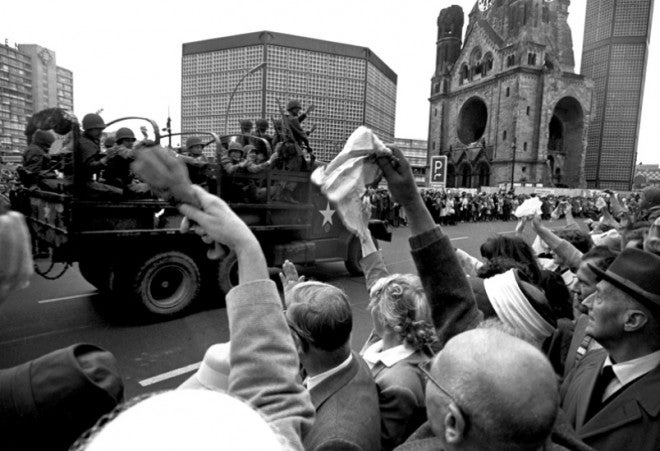
Original text: “Berlin, Germany, August, 1961: West Berliners cheer as a 1,500-man U.S. Army convoy from the 1st Battle Group rolls past the ruins of the Kaiser Wilhelm Church. The troops were sent by President John F. Kennedy to join the 11,000-man garrison already in the beleaguered city in a show of solidarity; they were greeted near the newly-constructed Berlin Wall by Vice President Lyndon Johnson.” These reinforcements are explicitly mentioned in R. Blake Stevens’ book U.S. Rifle M14: from John Garand to the M21. They are all armed with WWII-era small arms, including the M1. Image source: stripes.com

Original text: “American soldiers, Friedrichstrasse near Checkpoint Charlie, at the time of the contruction of the Berlin Wall, Germany, August 1961.” Soldiers and MPs in the background carry M1 Garand rifles. Image source: www.luzphoto.com

Original text: “American soldiers, Friedrichstrasse near Checkpoint Charlie, at the time of the construction of the Berlin Wall, West Berlin, Germany, August 1961.” An M1 Garand rifle is slung over the soldier’s shoulder. Image source: cdn.c.photoshelter.com

Original text: “American and East German soldiers, Checkpoint Charlie at the time of the construction of the Berlin Wall, West Berlin, West Germany, August 1961.” Note the M1 Garand rifle and M2 Carbine. Image source: contact.photoshelter.com
Once these images, which many considered outright damning of the US rifle program, surfaced, the Army took immediate action to send newly-made M14 rifles to Germany, even publishing a photo in Stripes magazine documenting the “changing of the guard” from the old M1 to the new rifle:

Original text: “Berlin, September, 1961: Sfc Walter Longanbach, right, supply sergeant of Company D, 6th Infantry, 2nd Battle Group, issues the new, fast-firing M14 rifles to three men of his company. The troops in three companies in West Berlin that received M14s were about to begin marksmanship lessons, followed by range firing; after that, they were to turn in their M1 Garand rifles, the standard infantryman’s weapon since 1941.” These M14s are very early models, and still retain the ventilated fiberglass upper handguard, later replaced by an unventilated model. Image source: stripes.com
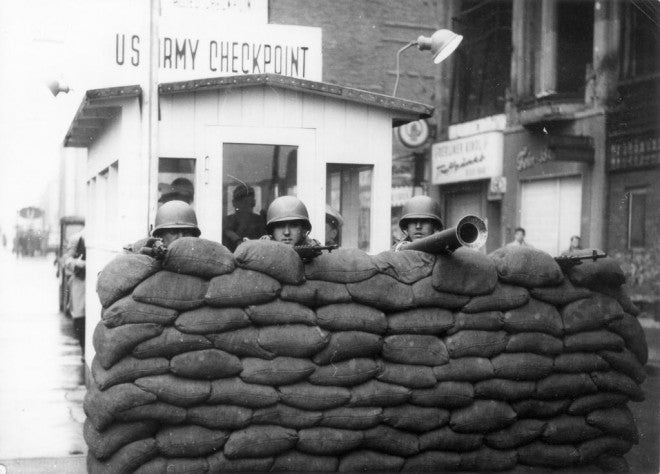
M14 rifles and an M20 anti-tank weapon being used by US soldiers in Berlin. Month unknown, but no earlier than September 1961. Image source: cvce.eu
This controversy was perhaps fomented by Allied troops being present with new 7.62mm NATO rifles:
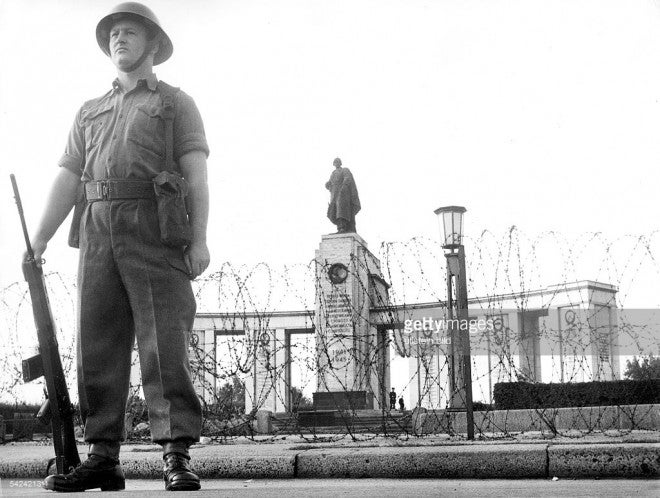
Original text: “Germany / GDR, West-Berlin, Tiergarten. British allied soldier in front of the soviet monument. September 1961 Germany / GDR, West-Berlin, Tiergarten. British allied soldier in front of the soviet monument. September 1961”. The soldier is using the new L1A1 rifle, first adopted by the British Army in 1954. Image source: gettyimages.com
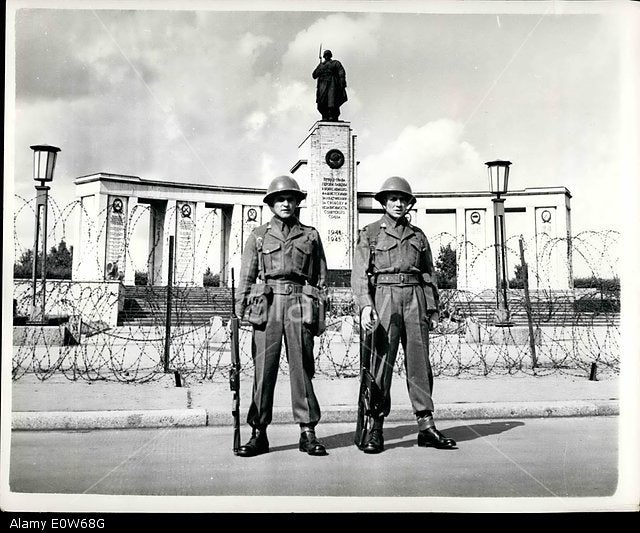
Original text: “Aug. 08, 1961 – British troops stand on guard before Soviet war memorial in West Berlin.” Note the L1A1 rifles. Image source: alamy.com
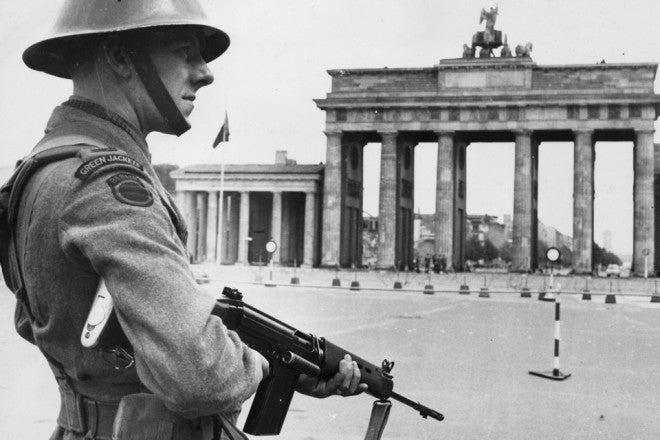
Original text: “A British soldier standing guard in West Berlin, as the East Germans added further restrictions on the crossing of the East-West border in 1961 in Berlin, Germany.” He carries an L1A1 rifle. Image source: thenational.ae
However, it wasn’t just US troops who stood off with World War II era weapons. Many of the East German border guards and troops carried antiquated WWII-era submachine guns and rifles, or early post-war carbines, as the menacing select-fire AK assault rifle had not yet shown up in quantity:
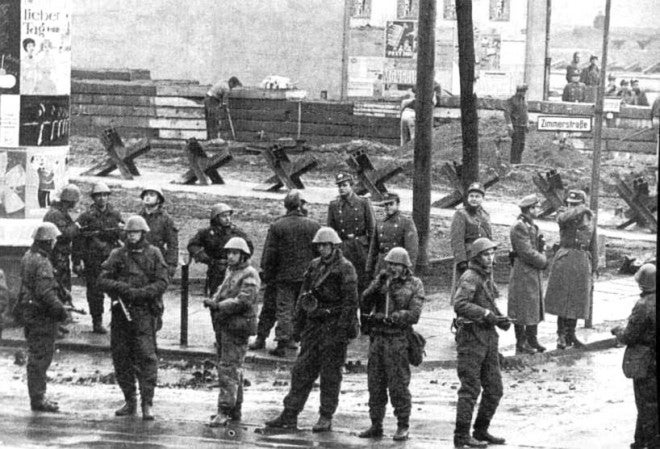
German troops stand guard at the East-West Berlin border, 1961. They are armed mostly with PPSh-41 submachine guns, but at least two have the much newer AKS-47 assault rifles. The modernized AKM rifle was just seeing initial issue with Russian troops, and had not yet been procured by the Nationale Volksarmee. Image source: mholloway63.wordpress.com

Original text: “14 August 1961, Erection of the Berlin Wall. GDR borderguards and members of a Combat Group of the Working Class at the border of the Berlin sector.” The rifleman in the distinctive East German helmet is carrying an SKS carbine, while the two Combat Group members are carrying antiquated Kar.98k rifles. Image source: en.wikipedia.org
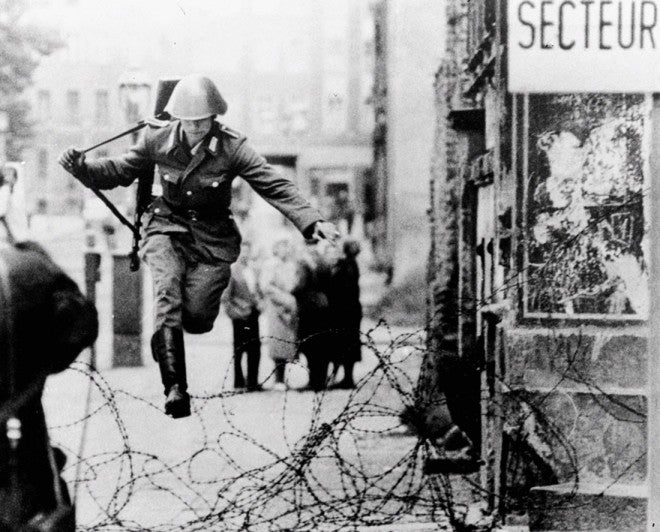
The famous photo of Conrad Schumann defecting to the West. Caught in mid jump, he carries a cigarette in his left hand, and a nearly 20-year-old PPSh-41 in the other. Image source: rarehistoricalphotos.com
The Berlin Crisis of 1961 and the initial absence of the M14 rifle would herald the end of the M14 program. Two years later, Robert McNamara would enact the immediate cessation of M14 rifle production, the temporary procurement of the M16 rifle, and the SPIW program, which was to take three years. Despite McNamara’s opinion that the M16 was an off-the-shelf and temporary solution to the US rifle procurement problem, it proved to be neither. The troubles experienced by the M16 rifles and their users in Vietnam, which were caused by poor ammunition specifications, tainted powder, a lack of chrome-lining of the barrel to resist tropical conditions, and the lack of weapon-specific training and cleaning kits, have since come to overshadow those problems that dogged the M14 rifle program. Paradoxically, the M16 family of weapons proved to be far from a temporary fixture of US Army procurement, and new M4A1 Carbines – the M16’s short-barreled, modular descendant – continue to be procured for the US Armed Forces.
 Your Privacy Choices
Your Privacy Choices